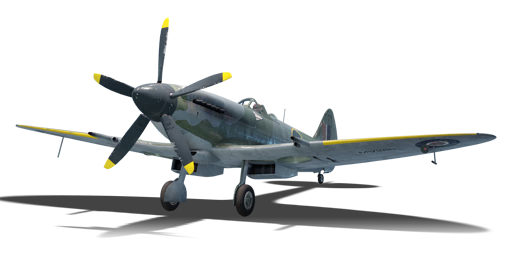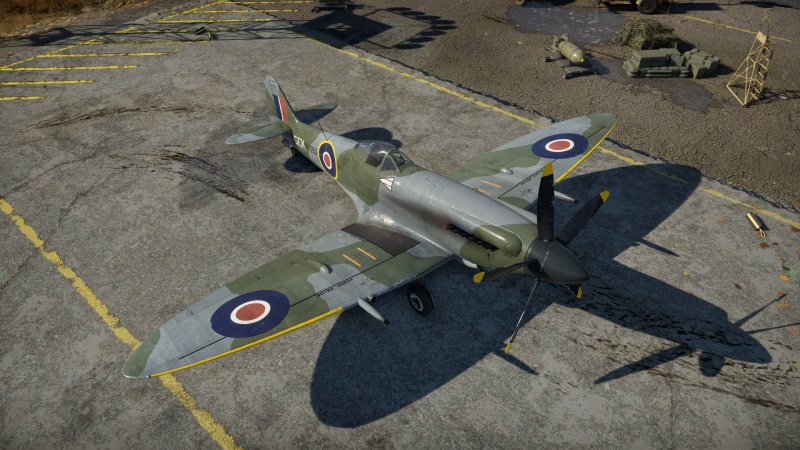Spitfire F Mk XIVe
| This page is about the British fighter Spitfire F Mk XIVe. For the premium version, see Spitfire FR Mk XIVe. For other versions, see Spitfire (Family). |
Contents
Description
The Spitfire F Mk XIVe was a British WWII-period fighter. Unlike the previous Griffon-powered Mk XIV, the XIVe featured a lowered tail section allowing for better rear view, as well as a new bubble canopy. The armament also differed from the regular Mk XIV as it featured an "E" type wing with two 20 mm Hispano cannons and two 12.7 mm Browning M2 machine guns instead of the "C" type with two cannons and four 7.7 mm machine guns.
The Spitfire F Mk XIVe was introduced in Update 1.41. Featuring much greater engine power due to its Griffon engine, the Mk XIVe is faster than the previous Merlin-powered variants, at the cost of decreased maneuverability. However, the Spitfire is still able to out-turn most of its opponents while retaining the great climb rate and speed.
General info
Flight performance
| Characteristics | Max Speed (km/h at 8,537 m) |
Max altitude (metres) |
Turn time (seconds) |
Rate of climb (metres/second) |
Take-off run (metres) | |||
|---|---|---|---|---|---|---|---|---|
| AB | RB | AB | RB | AB | RB | |||
| Stock | 690 | 670 | 12000 | 18.5 | 19.2 | 19.0 | 19.0 | 400 |
| Upgraded | 767 | 723 | 16.7 | 17.4 | 32.7 | 24.5 | ||
Details
| Features | ||||
|---|---|---|---|---|
| Combat flaps | Take-off flaps | Landing flaps | Air brakes | Arrestor gear |
| X | X | ✓ | X | X |
| Limits | ||||||
|---|---|---|---|---|---|---|
| Wings (km/h) | Gear (km/h) | Flaps (km/h) | Max Static G | |||
| Combat | Take-off | Landing | + | - | ||
| 794 | 260 | N/A | N/A | 260 | ~10 | ~6 |
| Optimal velocities (km/h) | |||
|---|---|---|---|
| Ailerons | Rudder | Elevators | Radiator |
| < 321 | < 400 | < 350 | > 500 |
| Compressor (RB/SB) | ||
|---|---|---|
| Setting 1 | ||
| Optimal altitude | 100% Engine power | WEP Engine power |
| 4,100 m | 1,510 hp | 2,150 hp |
| Setting 2 | ||
| Optimal altitude | 100% Engine power | WEP Engine power |
| 8,100 m | 1,340 hp | 1,852 hp |
Survivability and armour
- 38 mm Bulletproof glass in cockpit front.
- 4 mm Steel plates in pilot's seat.
- 4-7 mm Steel plates behind the pilot.
- 3 mm Steel boxes around the wing ammunition.
- 12.7 mm Steel plate between fuel tanks.
- 6 mm Steel plate in front of liquid cooling system.
Modifications and economy
Priority to research:
- Radiator - The stock engine overheats too fast, getting this upgrade first will be useful in dogfights where WEP is needed.
- Compressor - This is a good upgrade to get as the stock engine is pretty average.
- Offensive 20mm belts - While the 20mm belts are good for the, well, belts, the reason to research this is to research "New 20mm cannons" to sort of mitigate the jamming and accuracy of the 20mm.
- New 20mm cannons
- Engine - As the Spitfire will be facing mostly German planes which are primarily energy fighters, this upgrade will help with dogfighting German planes.
After that, the rest is up to the pilots preference, but research the fuselage repair last as it does little to the aircrafts performance.
Armaments
Offensive armament
The Spitfire F Mk XIVe is armed with:
- 2 x 20 mm Hispano Mk.II cannons, wing-mounted (135 rpg = 270 total)
- 2 x 12.7 mm Browning M2 machine guns, wing-mounted (260 rpg = 520 total)
Suspended armament
The Spitfire F Mk XIVe can be outfitted with the following ordnance:
- Without load
- 1 x 500 lb G.P. 500 lb Mk.IV bomb (500 lb total)
Usage in battles
The Spitfire F Mk XIVe, being outfitted with a Griffon engine, does not have as stellar of a climb rate as its Merlin engine counterparts. However, it still does have a very competitive rate of climb, and can usually come out above all but a few opponents. With such an altitude advantage, the pilot is able to choose which engagements to pursue, and the ability to choose engagements wisely is necessary. Since dogfighting in the Spitfire can involve prolonged turn-fights, make sure that no other enemies are nearby, or that if there are, that they can be dealt with by teammates. This plane's engines gives it great acceleration, and it also accelerates well in dives. Be careful though, since at very high speeds, sharp maneuvers may cause the wings to snap.
As far as maneuverability goes, the Spitfire is still very good at turning, especially at high altitudes. It also has a good roll rate, making rolling scissors maneuvers a viable tactic in dogfights.
With these flight characteristics, the Spitfire is a sort of jack of all trades. It can turn fight well, of course, but it can also boom and zoom or energy fight with much success. However, the plane does have some drawbacks. For one, the powerful engine is prone to overheating, so throttle and WEP management may be necessary. Additionally, performance at low altitudes can be inadequate in certain situations. Finally, the only ordnance that the plane can carry is a single 500 lb bomb. While this can certainly destroy an enemy tank in ground realistic battles, precise aim is required to do so consistently, and the one bomb is the only anti-tank weapon that the plane has. Still, it excels in an anti-fighter role in ground RB; its excellent maneuverability is well suited for the gamemode's tendency to involve one on one dogfights.
The Spitfire F Mk XIVe carries a fairly standard ammunition count: not particularly high and not very low. It's possible to spray a little bit, but it is also wise to keep an eye on your ammo count, and to preserve ammunition if possible.
Manual Engine Control
| MEC elements | ||||||
|---|---|---|---|---|---|---|
| Mixer | Pitch | Radiator | Supercharger | Turbocharger | ||
| Oil | Water | Type | ||||
| Not controllable | Controllable Auto control available |
Not controllable Not auto controlled |
Controllable Auto control available |
Combined | Controllable 2 gears |
Not controllable |
Supercharger - Use gear 1 from sea level to 4,000 m. Once you've hit roughly 4 km, switch to supercharger gear 2 to maintain performance. The output of the engine in the first gear will slowly gain from sea level to 2 km, then at 4 km and above it will begin to drop performance, which is when you should switch to the second supercharger stage.
Pros and cons
Pros:
- Very good at turning, especially at high altitude
- Excellent climb rate
- Very powerful engine that provides a very good acceleration
- Very good dive rate
- Good roll rate
- Very accurate guns when modifications have been researched and equipped
- Lots of ammo for cannons and machine guns
- Can perform turn-fights, Boom-and-Zoom and energy fighting equally
- Effective counter to high-altitude fighters (Ta 152, G.56, etc.)
- Bubble-style canopy offers excellent visibility for simulator battles
- Good turn rate at low speeds
Cons:
- Poor performance and maneuverability at low altitude
- No combat flaps configuration
- Gear and landing flaps rip easily: safe landings must be approached very slowly
- Oil and water overheat quickly
- Guns perform inadequately when stock
- Insufficient close air support payload options
- Inadequate armament for hunting heavy bombers like the B-17G-60-VE or the G8N1
- Poor wing lift coefficient when at high altitude, low speeds and stock
History
| Archive of the in-game description | |
|---|---|
|
The Supermarine Spitfire Mk.XIV was a single engine, single seat fighter which served with the Royal Air Force during the Second World War. In 1941 the Spitfire Mk.IV was the first Spitfire to be trialed with the new Rolls Royce Griffon engine. By the time the Griffon Spitfire entered service with the RAF in February 1943, subsequent modifications had redesignated the aircraft as the Spitfire Mk.XII. As successful as this new Spitfire was at low altitudes, the Mk.XII's performance was actually inferior to the Merlin engine Mk.IX at medium and high altitudes. Thus, the Spitfire Mk.XIV entered service as an interim fix. Fitted with a Rolls Royce Griffon 65 with two-stage supercharger producing 2,050 hp, the Mk.XIV immediately corrected many of the performance shortcomings suffered by the Mk.XII. The fuselage was strengthened to harness the powerful engine and a five bladed Rotol propeller replaced the earlier four bladed examples. Early models were fitted with the Type C wing although later Mk.XIVs were equipped with the Type E wing housing two 20 mm Hispano cannons and two .50 cal Browning machine guns or four 20 mm cannons, as well as a high visibility teardrop canopy. A common modification to the Mk.XIV was the clipped wing, which increased roll rate and gave a marginal increase to speed, but at the most of rate of climb. The Spitfire Mk.XIV entered service with Nos. 91, 322 and 610 Squadrons in southeast England where it saw notable success as an interceptor against V-1 Flying Bombs but also as part of the 2nd Tactical Air Force in operations over occupied Europe. Spitfire Mk.XIVs were also planned for use in the Far East but whilst a number of airframes were shipped to Burma, none were operational before the end of the war. The Spitfire Mk.XIV met mixed reviews from its pilots; whilst there was no doubt of the huge performance increase the new variant offered, it was uncomfortable to fly and lacked the balance and control harmonization of earlier Merlin engine Spitfires. Just under 1,000 Spitfire Mk.XIVs were produced with exports being employed by the Air Forces of India, Belgium and Thailand. | |
Media
- Skins
- Videos
See also
Links to the articles on the War Thunder Wiki that you think will be useful for the reader, for example:
- reference to the series of the aircraft;
- links to approximate analogues of other nations and research trees.
External links
| Supermarine | |
|---|---|
| Spitfires | |
| Merlin engine | Spitfire Mk Ia · Spitfire Mk IIa · Spitfire Mk.IIa Venture I · Spitfire Mk IIb |
| Spitfire Mk Vb · Spitfire Mk Vb/trop · Spitfire Mk Vc · Spitfire Mk Vc/trop | |
| Spitfire F Mk IX · Spitfire F Mk IXc · Spitfire F Mk XVI | |
| Spitfire LF Mk IX · Plagis' Spitfire LF Mk IXc | |
| Griffon engine | Spitfire F Mk XIVc · Spitfire F Mk XIVe · Prendergast's Spitfire FR Mk XIVe · Spitfire F Mk XVIIIe · Spitfire F Mk 22 · Spitfire F Mk 24 |
| Export | ▄Spitfire Mk Vb/trop · ▃Spitfire LF Mk IXc · ▂Spitfire Mk IXc · Spitfire Mk IXc · Spitfire Mk.IX (CW) · Spitfire LF Mk.IXe Weizman's |
| Seafires | Seafire LF Mk.III · Seafire F Mk XVII · Seafire FR 47 |
| Export | ▄Seafire LF Mk.III |
| Jet fighters | Attacker FB 1 · Attacker FB.2 · Scimitar F Mk.1 · Swift F.1 · Swift F.7 |
| Hydroplanes | Walrus Mk.I |





